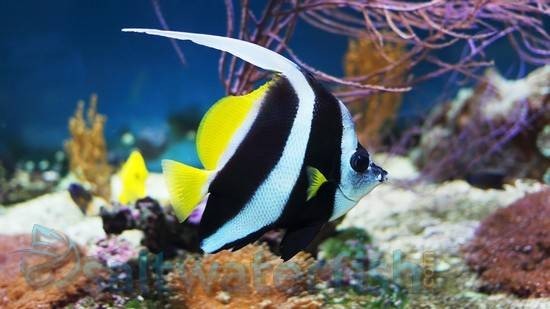Black & White Heniochus Butterfly Fish SaltWater
Fish Vero Beach 251 viewsShipping Details:
Free Shipping with $140 or more in Marine Life orders.
The Black and White Heniochus Butterfly, Heniochus acuminatus, also known as simply the Heniochus Butterfly, or the Longfin Bannerfish. This is one of the most eye-catching butterfly species available. It's colored with a bold pattern of white and black bands contrasted with bright yellow caudal fins and it has a wonderful long extension to its dorsal fin. This is a very popular butterflyfish and an excellent choice for the aquarists with some experience, especially for an aquarist who craves having a Moorish Idol, Zanclus cornutus. These two species are quite similar in appearance but the Black and White Heniochus is hardier and much easier to care for. The Heniochus Butterfly can grow up to 8 inches and should be kept in a tank no less than 60 gallons. It is not reef safe, as it will nip at sessile inverts and some coral polyps. It does well in a fish-only tank, with plenty of live rockwork to provide rock overhangs, and caves for hiding. Along with plenty of open space for swimming. Water quality is important as well so an adequate biological filtration system is necessary. The Heniochus Butterfly can be territorial and aggressive with members of its own species, but can be kept in groups of odd numbers, and in larger tanks of 120 gallons, and must be introduced all at the same time. In pairs, one will dominate the other. They shouldn't be housed with fin-nippers like Damsels, Triggers, and some Angels that will nip at the dangling pennant. The Heniochus Butterfly should be fed an omnivorous diet consisting of live Brine shrimp, Mysis shrimp, Worms, along with herbivore preparations and a Spirulina formula. Overall, this is one of the most striking and unique butterflies available and can be a great showpiece in your aquarium. They will thrive in a temperature range of 72 - 78??F and a pH of 8.1-8.4.














![[2x] LIVE Green Sailfin Molly Fish Full Marine Saltwater Mollies Poecilia](https://i.ebayimg.com/images/g/YE0AAOSwm2tkP0SA/s-l500.jpg)









